{ DOWNLOAD AS PDF }
ABOUT AUHTORS
Neerugatti Dorababu, Battu Ganga Rao, Devarakonda Ramadevi*
A.U. College of Pharmaceutical Sciences, Andhra University,
Visakhapatnam, Andhra Pradesh (A.P), India
*ramapathi.addepalli@gmail.com
ABSTRACT:
The study was aimed at investigate the effect of methanolic extract of Tamilnadia ulignosa (Retz.) (Rubiaceae) on general mating behaviour, libido, and adverse effects on sexually normal male albino rats. Methanolic extract was administered orally at the dose of 100, 200, and 400 mg / kg, to different groups of male rats (n = 8) once a day for 14 days . All the doses resulted in significant increase in mount frequency, intromission frequency and anogenital sniffing when compared to normal. The methanolic extract of Tamilnadia ulignosa (Retz.) bark at higher concentration (400 mg/kg body weight) showed significant aphrodisiac activity on male Wister albino rats as evidenced by an increase in number of mounts and mating performance. Thus, in experimental rats, the results of the present study suggest that the methanolic extracts of Tamilnadia ulignosa (Retz.) exert significant aphrodisiac activity
[adsense:336x280:8701650588]
REFERENCE ID: PHARMATUTOR-ART-2481
|
PharmaTutor (Print-ISSN: 2394 - 6679; e-ISSN: 2347 - 7881) Volume 5, Issue 4 Received On: 12/12/2016; Accepted On: 23/12/2016; Published On: 01/04/2017 How to cite this article:Neerugatti D, Battu GR, Devarakonda R;Evaluation of aphrodisiac activity of tamilnadia ulignosa (retz.) bark; PharmaTutor; 2017; 5(4);55-65 |
INTRODUCTION:
The term aphrodisiac is derived from Greek mythology, where Aphrodite was the goddess of love and beauty [1] . The Greek word ‘aphrodisia’ means sexual pleasure [2]. The modern definition of aphrodisiac can vary, but is generally regarded as a substance that increases sexual desire (i.e. libido) and/or sexual pleasure. The definition has been extended to include those substances which enhance sexual performance or aid in the proper functioning of the male and female sex organs [3,4]. Substances include foods, beverages, vitamins, minerals, and other natural and synthetic chemicals[5] . There are numerous reports of aphrodisiac activity attributed to plants [6,7,8,9,10,11,12], isolated constituents. [13]
MATERIALS AND METHODS
Preliminary Phytochemical studies The powder of dried leaves of Tamilnadia ulignosa (Retz.) (family Rubiaceae) was subjected to continuous soxhlet extraction with various organic solvent such as methanol. The 1:3 ratio for drug to solvent was maintained for each solvent for successive solvent extraction method. After concentration and drying of each extract in vacuum desicator, identification of phytoconstituents was carried out using thin layer chromatography method by different detecting reagents. 11 The all extracts were then subjected to qualitative chemical tests for confirmation of phytoconstituents of interest.
Preparation of extracts The leaves of Tamilnadia ulignosa (Retz.) were collected from Tirumala hills, Chitoor, Andhra Pradesh, India and authenticated by Dr. Madhava shetty, taxonomist, Department of Botany, Sri Venkateswara University, Andhra Pradesh. Shade dried leaves of Tamilnadia ulignosa (Retz.) were powdered and separately extracted in a Soxhlet apparatus for 6 hrs with methanol and then concentrated under vacuum at temperature of 45oc by using rotary evaporator (Buchi), dried completely, weighed and stored in desiccators.
Requirements Sildenafil citrate [Shilpa antibiotics, Raichur, India.] Progesterone capsules (100 mg) [Alembic limited, Vadodara, India] Oestradiol valerate injection (10mg/ml) [German Remedies, Mumbai.] Olive oil [s.d.fine Chem Ltd. Mumbai ] Ethyl Alcohol [The Ugar Sugar Works Ltd. Ugar Khurd, Belgaum] REMI research centrifuge (R-24) Borosil Soxhlet extractor Solvent evaporator. Research microscope (Metzer) Afcoset Digital balance(E-R-180 A) Mini Lyotrap Dryer (LTE Scientific Ltd, Great Britain) were purchased from Sigma chemicals, USA. All chemicals used in the study were of analytical grade.
Animals Albino rats (National Institute of Nutrition, Hyderabad, India) of either sex weighing 200-250gm were used in the studies. The animals were maintained under standard laboratory conditions at an ambient temperature of 23±2±C having 50+-5% relative humidity with 12h light and dark cycle. The use and care of the animals in the experimental protocol has been approved by the local Institutional Animal Ethics Committee (Regd. No. 516/01/A/CPCSEA) following the guidelines of the Committee for the Purpose of Control and Supervision of Experiments on Animals (CPCSEA), Government of India.
Evaluation for aphrodisiac activity[14,15] Adult, healthy male Albino rats weighing between (150-200 g) were divided into eight groups, each consisting of five rats. Group-A: Received distilled water (normal control) p.o. Group-B: received dose of Sildenafil citrate (0.7 mg/kg) p.o. Group-C: received low dose of Tamilnadia Ulignosa (Retz.) (100mg/kg) p.o. Group-D: received medium dose of Tamilnadia ulignosa (Retz.) (200mg/kg) p.o. Group-E: received high dose of Tamilnadia ulignosa (Retz.) (400mg/kg) p.o. All the treatments were given continuously for 14 days. On the 14th day, after treatment, all animals were allowed for mating and were recorded for evaluating aphrodisiac activity. All the animals showed quick mount latency, increased number of mounts, delayed intromission latency and increased number of intromissions in comparison to normal animals. All the animals showed delayed inter intromission interval and able to attain more intromissions and more ejaculations in comparison to normal animals (Table).
Effect on Stress modulated sexual behavior in male rats Male Albino rats weighing between (250-300 g) were divided into following leaven groups, each group consisting of five rats. Group-A: normal control (receives distilled water 3ml/kg) (without stress) p.o. Group B: stress control (receives distilled water 3ml/kg) p.o. Group-C: received low dose of Tamilnadia ulignosa (Retz.) (100mg/kg) p.o. Group-D: received medium dose of Tamilnadia ulignosa (Retz.) (200mg/kg) p.o. Group-E: received high dose of Tamilnadia ulignosa (Retz.) (400mg/kg) p.o. Group-F: received dose of Testosterone 0.05mg per rat i.m. All the treatments were given for 28 consecutive days before Immobilization stress. [16]
Induction of Immobilization stress The animals were subjected to IMB stress by Plexiglas cylinder (5 cm diameter and 16 cm large) for 6 h a day during light period started from 10 am each day for 28 consecutive days. Water and food were withdrawn during stress period.
Sexual accessory Organ to body weight ratio
Body weight of each animal was measured on day 1 before the IMB stress and on day 28 after IMB stress and drug treatment. The percentage change in body weight was calculated. Animals were sacrificed on day 28 by euthanasia with ether, accessory sexual organs viz, testis, vasdeferens, prostate glands, seminal vesicles, epididymis and adrenal glands were isolated and weighed in wet condition to measure organ to body weight ratio.
Sperm count
1. Spermatozoa were collected by flushing the vas deferens and epididymis in 2.0ml of normal saline. Draw the semen in the WBC pipette up to 0.5 mark. Draw in 4% sodium bicarbonate in 1% phenol solution up to the mark 11, making a dilution of 1 in 20. Count the sperm under high power in the four WBC squares.
Calculation: Number of sperms in 1 cu.mm of sample = N x 10/4 x 20
Number of sperms in 1 ml (i.e.1 cu.cm) of sample:
= N x 50 x 1000(as 1 cu.cm=1000cu.mm)
= N x 50,000
Where N is the total sperm count observed in outer four square of WBC chamber
Sperm motility Place a drop of semen on the cover slip and invert it on a rim of plasticine on the cavity slide. Examine under high power objective and find out the percentage of immobile to mobile sperms.
Histology of testis
Two-left testis of each group was excised and rinsed in 0.9% saline blotted dry of saline and excess blood. They are fixed in 12 % formalin for 24 hrs. The tissues, after fixation, were washed in water to remove excess fixative. Washed tissues were dehydrated through a graded series of ethyl alcohol, cleared with xylene and embedded in paraffin wax. Sections were cut at 3 μm with microtone blade, and mounted on clean glass slide. The sections were routinely stained with haemotoxyllin and eosin. The stained slides were observed (400 X) in research microscope and photographed.
RESULTS
Table 1:Qualitative chemical examination of different extract of seeds of Tamilnadia ulignosa (RETZ.) bark (TU)
|
S.No |
Phytoconstituents |
TU |
|
1 |
Alkaloid |
- |
|
2 |
Carbohydrate |
+ |
|
3 |
Phytosterol |
+ |
|
4 |
Protein & Amino acid |
- |
|
5 |
Saponin Glycoside/ glycoside |
+ |
|
6 |
Fixed oil / fat |
+ |
|
7 |
Gum/ mucilage |
+ |
|
8 |
Flavonoids |
+ |
|
9 |
Volatile oil |
- |
|
10 |
Amino acids |
+ |
|
11 |
Tannin |
+ |
NOW YOU CAN ALSO PUBLISH YOUR ARTICLE ONLINE.
SUBMIT YOUR ARTICLE/PROJECT AT editor-in-chief@pharmatutor.org
Subscribe to Pharmatutor Alerts by Email
FIND OUT MORE ARTICLES AT OUR DATABASE
Table 2: Effect of Tamilnadia ulignosa on aphrodisiac potential of male rats
|
Sl. No. |
Treatment |
Dose |
Mount frequency |
Mount latency (sec) |
Intromission frequency |
Intromission latency (sec) |
Anogenital sniffing |
|
|
Control |
distilled water 3ml/kg |
3.5±0.56 |
15.16±6.21 |
1.6±0.33 |
322.5±10.18 |
3.16±0.60 |
|
|
Sildenafil citrate |
0.7 mg/kg |
10.3±1.17** |
101.83±4.26** |
3.8±0.65** |
220.8±9.20** |
11.3±0.95** |
|
|
TUML |
100mg/kg |
4.1±0.47ns |
238.16±3.10** |
1.8±0.30ns |
306±7.45ns |
3.5±0.42ns |
|
|
TUMM |
200mg/kg |
5.1±0.30ns |
174.5±2.08** |
2.1±0.30ns |
264.6±6.90** |
6.6±0.4** |
|
|
TUMH |
400mg/kg |
7.5±0.42** |
144.5±2.86** |
3.3±0.49* |
243.6±6.06** |
9.8±0.60** |
Significance difference in control and extracts treated groups were determined by one –way analysis of variance (ANOVA) *** P<0.001 * P<0.05 are significant and NS P> 0.05, are not significant. All values are means of individual data obtained from six rats (n=6)
Table 3: Effect of Methanolic extract on stress modulated body and vital organ weights in adult male rats
|
Treatment |
Change in Body Weight ( % in g) |
Testes (mg/g) |
Vasdeferens (mg/g) |
Seminal vesicles (mg/g) |
Adrenal Glands (mg/g) |
Prostate Gland (mg/g) |
Epididymis (mg/g) |
|
Normal control D. water 3 ml/kg |
35.28±6.30 |
8.16±8.22 |
0.24±0.02 |
2.03±0.04 |
0.09±0.01 |
1.44±0.01 |
1.69±0.02 |
|
Stress Control D.water 3 ml/kg |
18.54±0.88 |
4.23±4.15** |
0.19±0.19** |
1,22±1,22** |
0.04±0.04** |
0.95±0.95** |
1.04±1.04** |
|
Testosterone 0.05mg per rat |
21.94±1.03 |
7.71±7.69** |
0.25±0.25** |
2.26±2.26** |
0.08±0.08 |
1.15±1.15** |
1.44±1.44** |
|
TUML (100 mg/kg) |
9.07±0.06 |
3.96±3.96 |
0.14±0.14ns |
1.24±1.24ns |
0.02±0.02 |
0.70±0.69ns |
0.60±0.59 |
|
TUMM (200 mg/kg) |
16.03±0.21 |
5.32±5.32** |
0.15±0.15ns |
1.67±1.66** |
0.05±0.05 |
0.81±0.81ns |
0.81±0.82* |
|
TUMH (400 mg/kg) |
22.01±0.08 |
6.12±6.07** |
0.24±0.20** |
2.16±2.05** |
0.07±0.07 |
1.14±1.14** |
1.28±1.26** |
Table 4: Effect of Testosterone and methanolic extract on Sperm Count (Total x 106) instress modulated rats:
|
Treatment |
Sperm Count (Total x 106) Mean±SEM |
|
Normal Control |
78.66±2.41** |
|
Stress Control |
36.66±1.8 |
|
Testosterone |
77.5±0.76** |
|
TUML (100 mg/kg) |
50±1.3** |
|
TUMM (200 mg/kg) |
64.1±1.47** |
|
TUMH (400 mg/kg) |
77.16±0.60** |
Table 5: Effect of Testosterone and methanolic extract on Sperm Motility (%) in stress modulated rats
|
Treatment |
Sperm Motility (%) Mean±SEM |
|---|---|
|
Normal Control |
60.6±2.0 |
|
Stress Control |
35.3±2.6 |
|
Testosterone |
58.1±0.7 |
|
TUML (100 mg/kg) |
44.5±1.4* |
|
TUMM (200 mg/kg) |
45.6±1.2** |
|
TUMH (400 mg/kg) |
54.6±1.5** |
Figure 1: Effect of distilled water on normal histology of rat testis
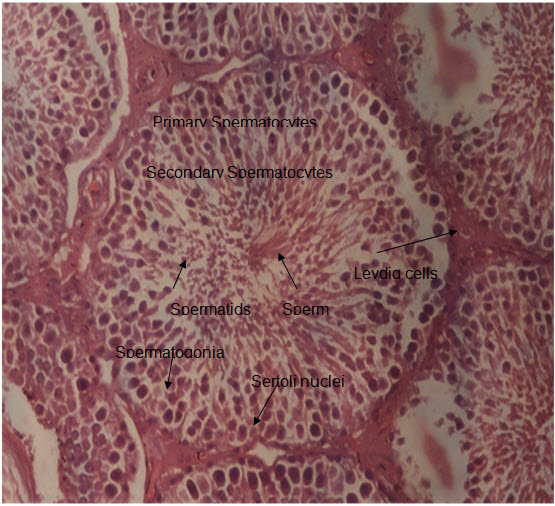
NORMAL CONTROL
Normal arrangement of basement membrane, spermatogonia, having primary and secondary spermatocytes, spermatids, sertoli cells and leydig cells (H and E, ×400). The lumen of the seminiferous tubule contains spermatozoa as well as cellular debris discarded during the transformation of spermatids into spermatozoa
NOW YOU CAN ALSO PUBLISH YOUR ARTICLE ONLINE.
SUBMIT YOUR ARTICLE/PROJECT AT editor-in-chief@pharmatutor.org
Subscribe to Pharmatutor Alerts by Email
FIND OUT MORE ARTICLES AT OUR DATABASE
Figure 2: Effect of distilled water in stressed rat testis.

STRESS CONTROL
Derangement of basement membrane, spermatogonia,having less number of primary and secondary spermatocytes, spermatids,sertoli cells and leydig cells (H and E, ×400) The lumen of the seminiferous tubule contains less number of spermatozoa. There is the evidence of testicular inflammation.
Figure 3: Effect of testosterone in stressed rat testis

Presence of good semniferous tubules with uniform arrangement of primary and secondary spermatocytes with numerous sertoli cells, the connective tissue and the leydig cell are highly appreciated. There is no evidence of no inflammation.
Figure 4: Effect of Tamilnadia ulignosa on histopathological changes on stressed rat
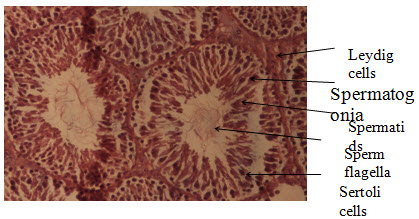
Thick arrangement of basement membrane, spermatogonia, spermatids ,sertoli cells, leydig cells and a few sperm flagella (H and E, ×400) aggregation of interstitial cells toward the basement membrane.
Figure 5: Histogram (Mount frequency) showing the aphrodiasic activity of methanolic extracts of T. ulignosa
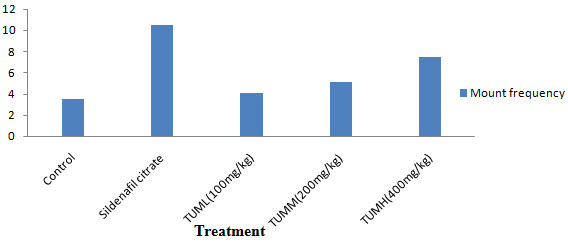
FigureNo:6 Histogram(Mount latency) showing the aphrodiasic activity of methanolicextracts of T. ulignosa.
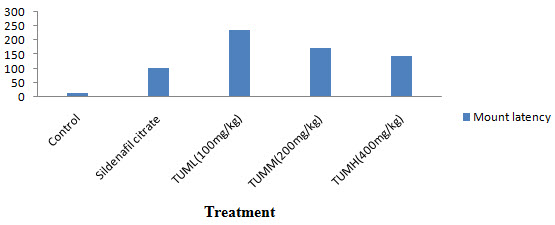
Figure No:7 Histogram(Intromission frequency) showing the aphrodisiac activity of methanolic extracts of T. ulignosa
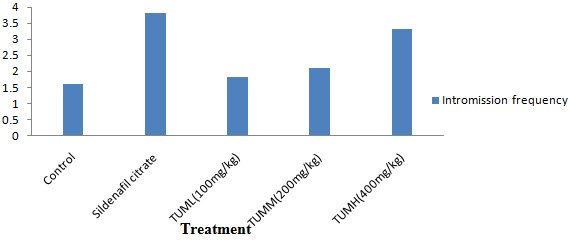
Figure No:8 Histogram(Intromission latency) showing the aphrodiasic activity of methanolic extracts of T. ulignosa
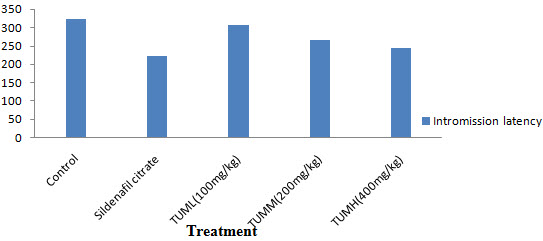
Figure No: 9 Histogram(Anogenital sniffing) showing the aphrodisiac activity of methanolic extracts of T .ulignosa

Figure 10: Effect of Testosterone and methanolic extract of Tamilnadia ulignosa on sperm count (Total × 106)
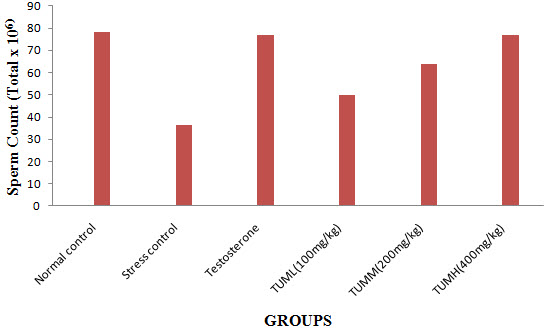
Figure 11: Effect of Testosterone and methanolic extract of Tamilnadia ulignosa on sperm motility (%)
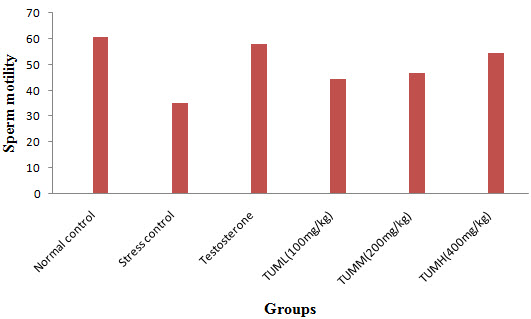
NOW YOU CAN ALSO PUBLISH YOUR ARTICLE ONLINE.
SUBMIT YOUR ARTICLE/PROJECT AT editor-in-chief@pharmatutor.org
Subscribe to Pharmatutor Alerts by Email
FIND OUT MORE ARTICLES AT OUR DATABASE
DISCUSSION
Phytochemical screening
The methanolic extract of Tamilnadia ulignosa bark were subjected to qualitative photochemical screening for the detection of phytoconstituents like carbohydrates, alkaloids, tannins, phenolics, saponins, flavonoids, triterpenoids, steroids, glycosides, fixed oils, gums and mucilages. As shown in Table 1, the results revealed the presence of alkaloids, steroids, carbohydrates, glycosides, proteins, saponins, gums and mucilages. (Table 1)
Aphrodisiac activity
The aphrodisiac activity of methanolic extract of Tamilnadia ulignosa bark were studied on male Wistar albino rats at various dosages. The parameters observed during the study were mount frequency, mount latency, intromission frequency, intromission latency, ano-genital sniffing and genital grooming (Table 2).
Mount frequency:
The results revealed that a significant increase in mount frequency was observed in animals treated with methanolic extract of Tamilnadia ulignosa bark at a higher concentration of 400mg/kg body weight. Methanolic extract of Tamilnadia ulignosa bark at lower concentrations of 100,200mg/kg body weight were found to be inactive (Table 2, fig 5).
Mount latency
The experimental data revealed that a significant decrease in mount latency in animals treated with methanolic extract of 400mg/kg body weight. (Table 2, fig 6).
Intromission frequency
The intromission frequency is expected to increase if the test drug is effective. The results revealed that methanolic extract at higher concentration can be exhibited similar activity as that of standard drug. On the other hand, methanolic extract at lower concentration was found to be less active (Table 2, fig 7).
Intromission latency
The results revealed that the methanolic extracts at higher concentration of 100mg/kg body weight are highly active and possess potent aphrodisiac activity as compared to control animals. On the other hand, at lower concentration of 200,400mg/kg, body weight possesses moderate aphrodisiac activity in comparison to control animals. (Table 2, fig 8).
Ano-genital sniffing
A moderate increase in number of ano-genital sniffing was observed in animals treated with methanolic extract at higher concentration (400mg/kg body weight). At lower concentration of methanolic extract (100,200mg/kg body weight), the increase in activity was insignificant as compared to the control (Table 2, fig 9).
Sperm count and sperm motility
The results revealed that a significant increase in Sperm count and sperm motility was observed in animals treated with methanolic extract of Tamilnadia ulignosa bark at a higher concentration of 400mg/kg body weight. Methanolic extract of Tamilnadia ulignosa bark at lower concentrations of 100,200mg/kg body weight were found to be less active compared to higher dose.(Table 4,5,fig 10,11).
Histopathological studies
The results revealed that a significant change in thick arrangement of basement membrane, spermatogonia, having primary and secondary spermatocytes, spermatids, sertoli cells and leydig cells (H and E, ×400). The lumen of the seminiferous tubule contains less sperm flagella was observed in animals treated with methanolic extract of Tamilnadia ulignosa bark (fig 1,2,3,4)
CONCLUSION
In the present study, we were interested in establishing whether Tamilnadia ulignosa extract exhibited prosexual effects and, if this were the case, upon which of the physiological mechanisms the facilitatory actions were exerted. The prosexual effects of so called aphrodisiacs might be exerted at different levels, i.e. sexual arousal or performance. The data obtained in the present study with sexually active animals reveal that the facilitatory actions of the Tamilnadia ulignosa extract are being exerted on both the mechanisms of sexual arousal and performance.
The data presented here provides evidence about the ability of the crude extracts of Tamilnadia ulignosa bark to enhance male sexual behavior expression in sexually active rats and to promote sexual desire in sexually inactive male animals. The data obtained reveal that oral administrations of different doses of Tamilnadia ulignosa extract effectively facilitate several aspects of copulatory behavior. In the experimental analysis of male sexual activity, the concept of the existence of two different physiological mechanisms responsible for sexual behavior expression was introduced in the early 50s by Frank Beach. This notion holds that one of these mechanisms is responsible for sexual arousal and the other for sexual performance. This concept has been central for the neurobiology of sexual behavior.
The plant extracts were subjected for preliminary photochemical studies and aphrodisiac activity. The reports of photochemical studies showed the presence of alkaloids, steroids, carbohydrates, glycosides, saponins, gums and mucilages. Amount these compounds; some of the compounds definitely possess aphrodisiac activity. It was found that an increased copulatory sexual behavior and mounting were observed in animals treated with plant extract. The methanolic extracts of Tamilnadia ulignosa possess potent aphrodisiac activity as evidenced by an increase in number of mounts, ano-genital sniffing attitude, penile erection index, ejaculatory behavior and mating performance.
Finally, based on this preliminary data, it can be concluded that the herb Tamilnadia ulignosa is a safe drug without any known adverse effects and can be very useful in enhancing the male sexual activity and treating various sexual disorders like erectile failure, premature ejaculation, lack of sexual desire and ejaculatory incompetence. However, further detailed studies are needed to confirm the usefulness this plant extract in treating sexual disorders. This includes separation, purification, and characterization of different chemical constituents of these extracts and testing the aphrodisiac activity of purified compounds.
REFERENCES
1.Shamloul R., Natural aphrodisiacs; The Journal of Sexual Medicine;2010; 7(1); 39−49.
2.Krychman M.L., Gubili J., Pereira L., Holstein L., & Cassileth, B. Female sexual enhancers and neutraceuticals; Current Sexual Health Reports; 2007;4; 177−182.
3. Sandroni P: Aphrodisiacs past and present: A historical review. Clinical Autonomic Research; 2001;11(5); 303−307.
4. Krychman M L., Gubili J., Pereira L., Holstein L., & Cassileth B. Female sexual enhancers and neutraceuticals; Current Sexual Health Reports; 2007;4; 177−182.
5. Chandler R.F., Ginseng-Aphrodisiac; Can Pharm J; 1988; 121: 36–38.
6. Sreedhar M., Srinivasan K.K., Shanbhag T., Rao S.G., Aphrodisiac activity of Ipomea digita. Indian Drugs; 1993; 30; 165–169.
7. Ananthakumar K.V., Srinivasan K.K., Shanbhag T, Rao S.G., Aphrodisiac activity of the seeds of Mucuer pruriens. Indian Drugs 1994 ;31; 321–327.
8. Subramoniam M., Madhavachandran V., Rajesekharan S., Pushpangadan P.,Aphrodisiac property of Trichopus zeylanicus extract in male mice; J Ethnopharmacol;1997; 57; 21–27.
9. Singh G., Mukerjee T., Herbal aphrodisiacs: a review; Indian Drugs;1998; 34; 175–182.
10.Noumi P., Zollo P.H.A., Lontsi D : Aphrodisiac plants used in Cameroon. Fitoterapia 1998 ;69; 128–134
11.Sureshkumar PK., Subramoniam A., Pushpangadan P; Aphrodisiac activity of Vanda tessellata (Roxb) hook. Ex don extract in male mice; Indian J Pharmacol; 2000; 32; 300–304.
12. Waddell T.G., Ibach D.M., Modern chemical aphrodisiac; Indian J Pharm Sci 1989;51; 79–82
13. Hooi H, Hung SC, Ahmad PY. Effects of Eurycoma longifolia Jack (Tongkat Ali) on the Initiation of Sexual Performance of Inexperienced Castrated Male Rats. Exp Anim, 2000; 49(1);35-38.
14. Ratnasooria, Dharmasiri M.G., Effect of Terminalia Catappa seeds on sexual behavior & fertility of male rats; Asian J Androl, 2000; 2;213-219.
15. Inoko M., Kiharay Y., Morii I., Fujiwara H., dasayana S., Transition from compensatory hypertrophy to dilated failing heart ventricles in Dahi-salt sensitive rats; Am J Physiol; 1994; 267(36);471-482.
16. Jain AK. Manual practical physiology for MBBS. Semen analysis sperm count and motility, Arya publications; Sirmour; 2003; 1;176-77.
NOW YOU CAN ALSO PUBLISH YOUR ARTICLE ONLINE.
SUBMIT YOUR ARTICLE/PROJECT AT editor-in-chief@pharmatutor.org
Subscribe to Pharmatutor Alerts by Email
FIND OUT MORE ARTICLES AT OUR DATABASE










